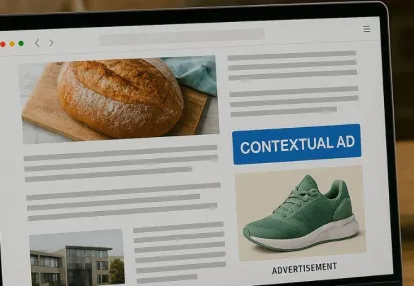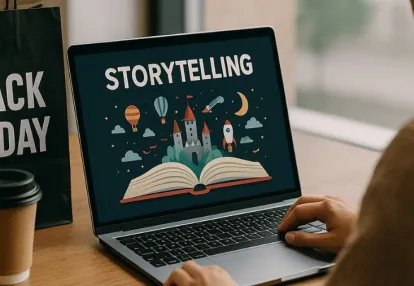
Our spy tools monitor millions of native ads from over 60+ countries and thousands of publishers.
Get StartedIn the ever-changing world of digital marketing, native advertising has become a powerful tool for businesses to connect with audiences in a more natural and meaningful way. Unlike traditional ads that often interrupt the user experience, native ads blend seamlessly into the platform they're on, making them less annoying and more interesting for users.
Native advertising has many advantages:
These ads have proven their worth in the marketing world. But what makes native advertising truly effective is its ability to fit in. By adapting to the style and tone of the content around them, native ads can deeply resonate with audiences, leading to higher click-through rates and conversions.
The future of native advertising looks bright. With Anstrex Native offering valuable insights on profitable native ad campaigns, businesses can stay ahead by spying on their competition and making more informed decisions about their advertising spend. As you read through this guide on creating impactful native ads, remember that staying ahead requires constant innovation and adaptation to changes in consumer behavior and technology trends. This is your chance to shine and make a difference with your native advertising campaigns.
Native advertising is a form of paid media where the ad experience follows the natural form and function of the user experience in which it is placed. Unlike traditional ads, which can be disruptive and stand out as separate from content, native ads blend in with the platform's regular content, making them less intrusive and more engaging.
Transparency is critical when it comes to native advertising. The Federal Trade Commission (FTC) mandates clear disclosure when content is sponsored. Here's why this matters:
By respecting these practices, you not only comply with legal requirements but also foster a trustworthy relationship with your audience.
When you're venturing into the world of native advertising, it's important to understand and apply certain best practices. These practices can greatly improve the impact of your ads, making sure they connect with your target audience and strengthen your brand.
Key Takeaway: To create truly impactful native ads, combine compelling creative formats with strategies that provide value, personalize the experience, and match your audience's interests.
Not all native ads are created equal. What works for one campaign might not work for another. That's why it's crucial to experiment with different creative formats and keep an eye on how they perform.
The most effective native ads go beyond just promoting something—they provide value. This could mean giving useful information, offering solutions to problems, or simply bringing joy to the user's day.
For example, a skincare brand could create an ad featuring tips for keeping skin healthy during the winter months. This not only provides value to users but also positions the brand as an expert in skincare.
Humor can be a great way to grab attention and create a positive impression of your brand. However, it's important to use humor carefully and appropriately. An ad for a fun, casual product like a mobile game can be light-hearted and silly, while an advertisement for a professional service should maintain a more serious tone.
Native ads should be personalized based on the specific interests, characteristics, and device preferences of your target audience. Customizing ads makes them more interesting and relevant to the viewer.
For example, a music streaming service might create different versions of an ad for various demographic groups—each featuring music from artists popular within that particular demographic.
Using a conversational style in your ad copy helps build genuine connections with users. However, it's important to balance this approach with clear reinforcement of your brand identity.
For instance, if your brand is known for its advanced technology solutions, your ads could use simple language to explain complex ideas while consistently highlighting innovation.
By following these best practices in your native advertising strategy, you're one step closer to creating ads that not only blend seamlessly into their surroundings but also stand out in terms of engagement and effectiveness.
Crafting compelling native ads is just one piece of the puzzle. The real magic happens when a user clicks on your ad and lands on your page. This is where user experience on landing pages comes into play.
A seamless post-click experience can be the difference between a user who bounces off your page and one who converts. Here are some strategies to ensure a smooth transition from ad click to conversion, creating a funnel for impact:
Slow-loading pages frustrate users, often leading them to abandon the site before it fully loads. To prevent this, optimize your landing pages for fast load times. Similarly, with mobile usage on the rise, it's crucial that your pages are mobile-friendly. This means they should look and perform well not only on desktops but also on smartphones and tablets.
A disjointed ad-to-page experience can confuse users, resulting in lost conversions. Ensure that the messaging, visuals, and branding elements in your ad align with those on your landing page. This consistency makes users feel like they've landed in the right place and encourages them to take the desired action.
The fewer barriers there are to conversion, the better. If you're asking users to fill out a form, only ask for essential information. Each additional field increases the likelihood that users will abandon the process.
Your CTA is arguably one of the most critical elements of your landing page. It should clearly tell users what action you want them to take - whether that's downloading an eBook, signing up for a webinar, or making a purchase.
Remember, while native ads bring users to your site, an optimized landing page is what turns those visitors into customers. It's a vital part of the conversion funnel that shouldn't be overlooked.
The future of native advertising will be heavily influenced by technology. One major trend is the growing popularity of programmatic native—a method that uses automation to buy, place, and optimize ads. This approach allows advertisers to target specific audiences more accurately and on a larger scale, using data analysis and machine learning to improve campaigns in real-time.
Here are some ways technology will impact native advertising:
Programmatic native offers the potential to make native advertising more efficient and effective by reducing manual tasks and allowing for smarter ad placements. For marketers to fully utilize the power of native advertising in today's digital world, it is crucial to stay updated on these advancements.
To stay ahead in the ever-changing world of native advertising, it's important to stay updated on new trends and technologies. Being innovative is crucial — don't be afraid to try out new ad formats, personalize your ads, or rethink how you create content. Make learning a continuous process because what works today may not work tomorrow.
Native advertising has tremendous potential. When done well, it allows businesses to form deeper connections with their audiences, build trust, and increase engagement. Remember, the most effective native ads are those that provide value to users and genuinely resonate with your target audience.
Use these best practices for native advertising as a starting point, but don't limit yourself to them. Explore. Refine. Improve. Your success depends on your ability to adapt and evolve alongside your audience.
Remember these key points as you navigate the world of native advertising:
By keeping these insights in mind, you'll be better equipped to make informed decisions and drive results with your native advertising efforts.
Receive top converting landing pages in your inbox every week from us.
Must Read
As third-party cookies fade away, contextual targeting is making a powerful comeback. Learn how to leverage native ads that align with user intent and content relevance to maintain high engagement and conversions. Discover modern tools and tactics that make cookie-free targeting both precise and scalable. Ideal for advertisers seeking privacy-friendly ways to drive performance in 2025 and beyond.
Liam O’Connor
7 minDec 9, 2025
Recently Updated
Native ads can make or break your holiday marketing success. Explore how to evaluate your recent campaigns and identify what worked—or what fell short—with native advertising. Learn key optimization tactics to boost engagement, strengthen audience trust, and increase conversions in future promotions. Ideal for marketers aiming to refine their ad strategies after the holiday rush.
Elena Morales
7 minDec 1, 2025
Quick Read
After Black Friday, shoppers crave more than just deals—they want connection and meaning. Explore how creative storytelling can turn post-sale campaigns into powerful conversion drivers. Learn how to craft narratives that build trust, strengthen brand loyalty, and inspire action beyond discounts. Perfect for marketers aiming to keep engagement high long after the sales frenzy ends.
Marcus Chen
7 minNov 29, 2025




